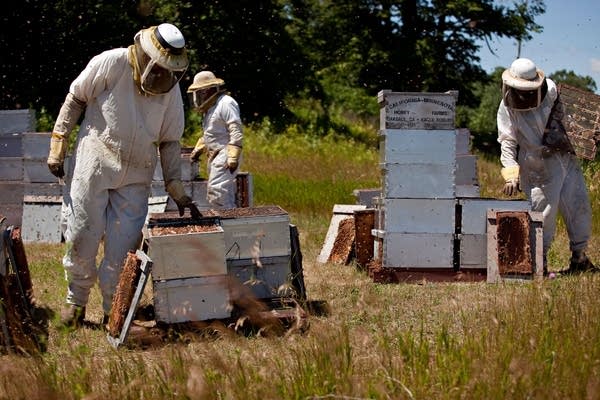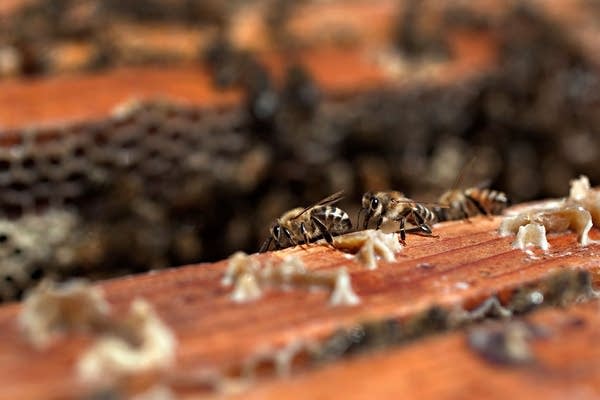Hive health: Beekeepers closely watch population, productivity

Beekeepers are working to overcome another year of significant bee losses from colony collapse disorder, which has killed millions of honey bees in Minnesota and across the country.
The losses, which have cut honey production, have researchers scrambling to understand the problem — and the potential interactions between pesticides, parasites and disease.
View more photos from Jeff Anderson's hive near Eagle Bend, Minn.
Create a More Connected Minnesota
MPR News is your trusted resource for the news you need. With your support, MPR News brings accessible, courageous journalism and authentic conversation to everyone - free of paywalls and barriers. Your gift makes a difference.
July is typically a busy month for bees, and peak time for honey production in Minnesota.
It's also a busy time for beekeeper Jeff Anderson, who keeps a close eye on his hives — not just to watch for honey, but also for disease.
A trip to the hive Monday was met with disappointment when Anderson, who held a smoker in one hand to calm the bees, pried the top off a wooden bee hive with a small metal bar.
"See, this hive here," he said. "Not nearly a good enough population to make a honey crop this season."
Bee keepers first started to notice their bees were dying five years ago. Anderson said his honey production is about half of what peak production was 10 years ago, when he averaged 480 barrels of honey, each containing 55 gallons. For the last five years he's averaged about 250 barrels.
Researchers say that nationwide, honey production rebounded last year after declining four of the previous five years. But honey prices have been high, taking the edge off the financial impact of reduced production.

Anderson, who has 35 years of experience as a beekeeper, is also a member of the National Honey Bee Advisory Board which provides bee industry input to federal regulators and researchers.
When Anderson works his way along stacks of hives, checking the health of the bees inside, he hopes to find a healthy queen bee and lots of workers in each hive.
But his look at four hives on Monday was only half as satisfying as it should have been. Two lacked queens.
"Our process of trying to keep our colony numbers is not going real well," he said.
Each year, Anderson loses about half of his bee hives. Eggs don't hatch into worker bees, and the hives begin to die. Scientists think the cause might be a combination of pesticides, parasites and disease.

Anderson tries to replace dying hives by dividing the bees in healthy hives to make two hives from one. That means giving up a year of honey production from the healthy hive. The bees spend all their energy rebuilding the population. And in this case the new hive he created is dying.
"The hive we tried to split was not successful. So you shot yourself in the foot on honey production on the original colony trying to keep colony numbers up," he said. "It's kind of playing Russian roulette. But you can't be in the beekeeping business without live colonies of bees."
Right now, Anderson said he's sacrificing honey production to keep enough bee hives alive to pollinate crops. The U.S. Department of Agriculture estimates bee pollination affects about $15 billion worth of crops each year.
Each January, Anderson loads up his hives and hauls them to California where farmers pay to have bees pollinate crops. And those pollination fees have in some cases tripled in the past few years.
"What I'm losing in honey production so far, we're pretty much able to offset it in the price of our paid pollinations out in California in the spring when we're out pollinating almond trees and fruit crops out there," he said.

That extra income means he still makes a small profit, but it might also contribute to the bees declining health.
Anderson said the bees pollinating crops in California are exposed to fungicides using on the crops. He said that kills bacteria the bees need to digest food.
He thinks it's just one more environmental factor weakening the bees' immune systems, making them more susceptible to natural diseases or parasites.
Researchers have found many reasons bees die. It might be from pests like varroa mite, or a virus, or starvation. Many researchers believe bees are more susceptible to diseases because they are in a weakened condition for some reason.
Researchers have yet to identify the underlying cause of colony collapse disorder. Many beekeepers believe expanded use of systemic pesticides is to blame. The chemicals are part of the plant, so bees are exposed every time they eat pollen.
But U.S.D.A. officials say there's no clear pattern that ties pesticides to colony collapse.
That leaves Anderson frustrated.
"It's kind of like a human aids patient that dies from pneumonia," he said. "What really killed him? Was it the pneumonia or was it the aids? Are we looking at the chicken or are we looking at the egg? A lot of us commercial beekeepers feel like there's a lot of researcher looking at the eggs and we're not looking for the chicken."
U.S.D.A. officials say scientists with the agency and universities across the country are changing the focus of colony collapse disorder research. Instead of looking for a single cause, they're looking at potential interactions between pesticides, parasites and disease.


